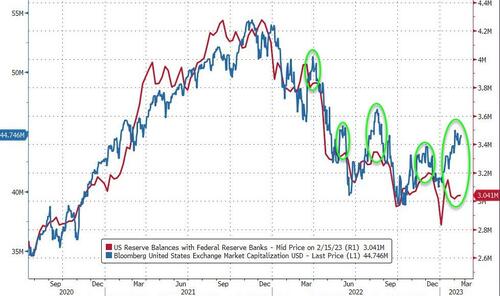Economics
“This Is Not Your Typical Recession”: BofA’s Subramanian
"This Is Not Your Typical Recession": BofA’s Subramanian
Authored by Naveen Anthrapully via The Epoch Times,
Bank of America (BofA) strategist…

“This Is Not Your Typical Recession”: BofA’s Subramanian
Authored by Naveen Anthrapully via The Epoch Times,
Bank of America (BofA) strategist Savita Subramanian believes the United States is not facing a “typical recession” and expects the economic slowdown to extend into the next year, while also raising alarm bells about the Federal Reserve’s quantitative-tightening policy.
“This is not your typical recession, because I think what’s happening is that you’ve still got a very strong consumer. Look at the retail sales data. Look at credit card data—jumped in January. Never underestimate the U.S. consumer,” Subramanian, the head of U.S. equity and quantitative strategy at BofA, said in an interview with Fox. U.S. retail sales had risen by 3 percent in January, which is the largest increase since March 2021. The jump followed a 1.1 percent decline in December.
However, the interviewer pointed out that the retail sales data are not adjusted for inflation and that the consumer was paying more for goods and services.
A note by BofA economists warned that the third quarter would mark the beginning of a delayed, shallower, and stretched-out recession that will go into first quarter 2024.
“Yes, it’s a longer, shallower, recession that extends into next year,” Subramanian confirmed in the interview.
“Demand may not be as weak as you see in a typical recession because we’re starting it with really healthy balance sheets.”
“Look at consumer balance sheets. Deposits today, based on our credit card data, are still higher than they were pre-COVID. So, we haven’t really seen that drama happen in consumer balance sheets that typically precedes a much deeper recession.”
Quantitative-Tightening Risk
In May 2022, the Federal Reserve announced a new cycle of quantitative tightening, a monetary policy aimed at reducing the central bank’s balance sheet by either selling government bonds or allowing these bonds to mature, thereby removing them from cash balances.
At the time, the Fed’s balance sheet had risen to roughly $9 trillion. The bank decided to allow the maturing of around $1 trillion worth of securities without reinvestment over a 12-month period.
Over $47 billion worth of assets were subjected to this policy each month for the initial three months, a limit that was raised to $95 billion per month subsequently. In the interview, Subramanian raised concerns about the Federal Reserve’s policy.
“What I worry about is that nobody is talking about quantitative tightening. The Fed bought trillions and trillions and trillions of dollars over the last 10 years. And now, they’re about to unwind that, they’re in the process of unwinding that. Why aren’t we more worried about that than the layoffs happening in technology stocks?” she said.
Drowning in Debt, Struggling to Pay Bills
In a sign of rising risk to the economy, Americans are slipping into more debt while also finding it difficult to make ends meet.
A report from the Federal Reserve Bank of New York this month, for example, found that credit card balances rose by $61 billion, to hit $986 billion in fourth quarter 2022, exceeding the pre-pandemic high of $927 billion. Delinquencies among borrowers also accelerated.
“Although historically low unemployment has kept consumer’s financial footing generally strong, stubbornly high prices and climbing interest rates may be testing some borrowers’ ability to repay their debts,” Wilbert van der Klaauw, an economic research advisor with the Federal Reserve bank of New York, said in a statement accompanying the report.
U.S. household debt hit a record $16.2 trillion in fourth quarter 2022, with debt balances growing by $394 billion during this period, which is the biggest quarterly increase in 20 years.
Meanwhile, Americans are struggling to pay their bills. According to Bankrate’s 2023 annual emergency savings report, 68 percent of Americans are worried that they will not be able to cover their living expenses for even a month should they lose their primary source of income.
In addition, 57 percent of adults were also found to be unable to afford a $1,000 emergency expense.
Tyler Durden
Fri, 02/17/2023 – 15:46
inflation
monetary
reserve
policy
interest rates
fed
central bank
monetary policy

Argentina Is One of the Most Regulated Countries in the World
In the coming days and weeks, we can expect further, far‐reaching reform proposals that will go through the Argentine congress.
Crypto, Crude, & Crap Stocks Rally As Yield Curve Steepens, Rate-Cut Hopes Soar
Crypto, Crude, & Crap Stocks Rally As Yield Curve Steepens, Rate-Cut Hopes Soar
A weird week of macro data – strong jobless claims but…
Fed Pivot: A Blend of Confidence and Folly
Fed Pivot: Charting a New Course in Economic Strategy Dec 22, 2023 Introduction In the dynamic world of economics, the Federal Reserve, the central bank…





















